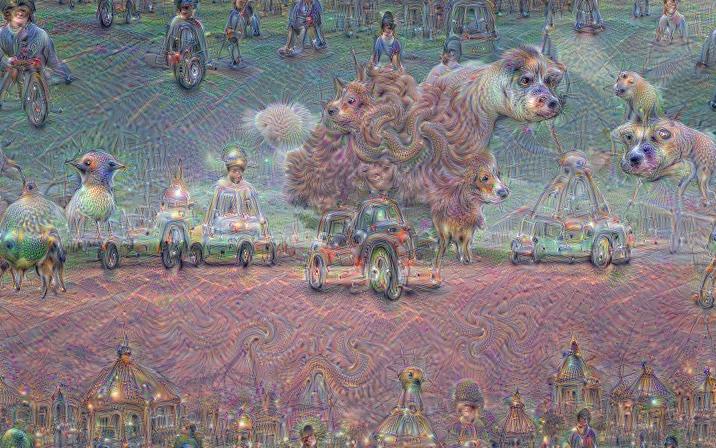Today this remarkable post by Google researchers is a sensation around, and for good reasons. It explains itself pretty well, but quickly speaking, here’s the kernel. Researchers developed artificial neural networks to recognize specific objects in an image (e.g. a dog, a dumbbell, a banana). To test the network, they run it in reverse, so to say: They start from a random image and let the network evolve a new image which, for it, corresponds to a desired object, or where it maximizes the quality of objects it recognizes. It is basically a test to see what the neural network recognizes as the essence of dog-ness, banana-ness or so what.
The images generated are nothing like what one would naively expect. They have an eerie, mesmerizing quality that is remarkably dream-like. And that is where your jaw starts to drop: this is not a coincidence. You are -quite literally- seeing dreams. The dreams of a machine.
How so? Most of the coverage in fact seems to focus on the eeriness of the images, and on how alien AIs are, but actually I think this sentence in the post deserves a Nobel prize for understatement:
So here’s one surprise: neural networks that were trained to discriminate between different kinds of images have quite a bit of the information needed to generate images too.
I am no neurology expert, so maybe it’s all old news. But it shocked me. It basically means that when a brain learns how to recognize things, it can also represent the same things. This is literally the birth of imagination. Biological brains evolved to recognize patterns: that is what you need for your senses to work. By doing that, now we know they automatically evolved the capability to generate new patterns. They did not need to evolve a new machinery. Imagination and future prediction is thus a byproduct of advanced pattern recognition: just run it backwards.
While to generate sensible behaviour this needs to integrate with other brain functions, hypnagogic hallucinations or dreams could conceivably be fueled by the same raw algorithm Google researchers used to generate their landscapes. Brain “noise” is pumped into pattern recognition/generation networks, and they form recognizable -even if weird- structures.
It is just one step from this to consciousness: when a brain understands patterns, generates new ones accordingly, and then recognizes what it generates, it is basically aware of itself.
These are just gut feelings, and I welcome if experts will tear them to pieces. But I feel our next key findings on consciousness and evolution of intelligence will come as much from computer scientists as from neurologists. By building brains we will understand brains: after all a brain is a brain is a brain, regardless of what is made of. We are biological robots, and robots can dream too.

Be First to Comment